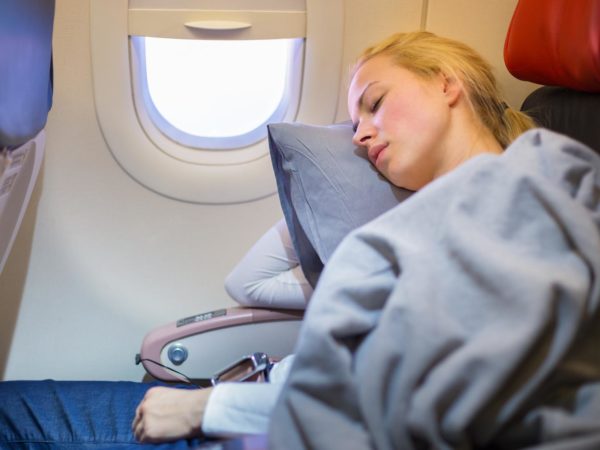Overcoming Jet Lag?
I know you recommend melatonin for jet lag, but I’m wondering about a method involving light exposure during sleep. Can you tell me anything about this, how it works and if it is available?
Andrew Weil, M.D. | May 17, 2016

Jet lag can blight a vacation and slow you down on a business trip. Your body can adjust its own clock to the time at your destination by only about an hour a day. That can be a problem if you’re making a weeklong trip abroad, say from Los Angeles to London, 8 time zones away.
The latest news about addressing jet lag comes from Stanford University, where researchers have shown that the body clock can adjust more quickly to a change in time zones when you’re exposed to short flashes of light while asleep. Researchers Jamie Zeitzer, Ph.D. and Raymond Najjar, Ph.D., found that short flashes of light at night work better at resetting the body clock than continuous light exposure in preparation for a trip. Dr. Zeitzer described this method as “biological hacking” that fools the brain into thinking the day is longer. He and Dr. Najjar enrolled 39 participants age 19 to 36 for their study and put them on a routine sleep-wake cycle, going to bed and waking up at the same times every day for two weeks. Then they brought the volunteers to the sleep lab and exposed some of them to continuous light for an hour while they slept and others to a sequence of flashes of various frequencies for an hour. Results showed that a sequence of 2-millisecond flashes – similar to a camera flash – 10 seconds apart led to a nearly two-hour delay in the onset of sleepiness and was the most efficient and fastest method of resetting the body’s clock. Exposure to continuous light changed the participants’ internal clock by only 36 minutes.
The flashes didn’t disturb the volunteers’ sleep, and Zeitzer and Najjar envision that the flashing light might be adapted to a sleep mask or bedside device for home use. More study is needed, however, to determine the practicality of this method.
In the meantime, there’s a smart phone app called Entrain developed by researchers at the University of Michigan that might help. With it you can get schedules of light and darkness depending on your travel itinerary. The schedules tell you what time during the day you should seek out the brightest light available and when you should spend time in the dark or in dim light. (You don’t have to sleep.) If you have to go out when you’re supposed to be avoiding light, you can use blue light-blocking glasses. And if you are supposed to expose yourself to bright outdoor light at an hour when it is pitch dark, you can use a therapeutic lightbox.
Here are my recommendations for minimizing jet lag:
• Drink plenty of water. Keep yourself well hydrated throughout the flight.
• Avoid caffeine and alcohol, and limit your sugary drink intake – these beverages can send your blood sugar on a rollercoaster ride.
• Food is harder to digest at high altitudes so eat lightly during the flight and avoid the high-salt, high-fat entrees being offered on the plane and at the airport.
• Get up and stretch now and then to stimulate your circulation.
• When you arrive, expose yourself to as much natural daylight as you can.
• Consider melatonin. You can significantly reduce jet lag by taking 2.5 mg of melatonin sublingually at bedtime for one or two nights after your arrival, regardless of the direction of travel.
Andrew Weil, M.D.
Source:
Raymond P. Najjar and Jamie M. Zeitzer, “Temporal integration of light flashes by the human circadian system.” Journal of Clinical Investigation, February 8, 2016, doi: 10.1172/JCI82306









